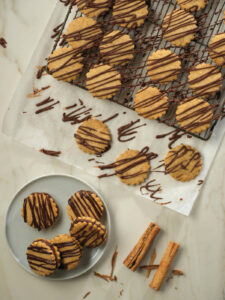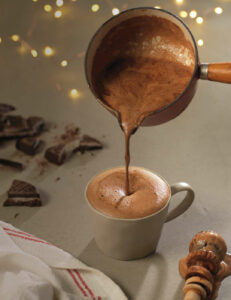
All the world loves a trendy cup
PHOTOGRAPHY BY PATRICK TREGENZA
Food history is splattered with trends. Yes, sometimes they make us want to roll our eyes, but it’s not fair to be dismissive. Novelty is often silly, but new things can lead us down wonderful paths.
Take for example, that time when people of all walks of life started drinking a special beverage all day long in special cups that everyone just had to have. Sounds like the latest social media wave.
But, in fact, it was everyday life in Colonial Mexico, as people came together several times a day around foamy, steaming mugs of chocolate. Loving chocolate that much is not really rational, but then, so many things are not.
Although there are earlier vestiges, Mayans were the first to domesticate the cacao plant. The fruits were collected, and the beans were fermented, toasted and finely ground.
The resulting powder was combined with hot water, strained and poured to create foam. The foam is essential to tasting, as it creates aeration that allows us to perceive all the complex aromatic compounds a good chocolate can have. The beverage was served hot or cold, and sometimes combined with masa, honey, vanilla bean, annatto, flowers or chiles.
Through trade, it became known and enjoyed by the Aztecs and the rest of the continent. It was one of the first gifts the Spanish conquerors received when disembarking, and they took it back home.
According to Salvador Novo—one of the greatest Mexican food writers—the encounter of both cultures was a fortunate one, at least from a culinary perspective. Cacao benefited from the addition of sugar and milk, and later from European processing techniques.
People were so serious about their chocolate in Colonial Mexico that they took special plates with affixed cups, called mancerinas, to mass with them. These plates were designed to hold the hot chocolate in place while leaving room for cookies without risking anything falling off, even while traveling, or if you had shaky hands, hence the French name for these dishes, tasses trembleuses.
A bishop in Chiapas tried to prohibit chocolate drinking during mass, claiming it was a distraction and broke churchgoers’ fast. People protested; he experienced a mysterious death. A few years later, in 1636, Antonio de Leon wrote one of the most interesting books on chocolate titled Moral Question: Whether Chocolate Breaks the Ecclesiastic Fast. It justifies, in an almost poetic way, how chocolate is good for mood and attention, and concludes it did not break the fast because it is just a beverage. The book ends with several health remedies and chocolate recipes, to be enjoyed hot or cold.
Meanwhile, in Europe, hot chocolate houses were opening everywhere. Each country varied the recipe slightly. Even nowadays, the Parisian chocolat chaud, sipped preferably at a sidewalk café, is served so impossibly thick that it can practically hold up a spoon vertically in the cup. In Madrid, where folks at odd hours dip churros into a cup of hot chocolate, the line between sauce and drink is blurry. In Vienna you usually need to work through a cloud of whipped cream to get to the bitter silky mix; while in New York, there are always related novelties, like torched marshmallow rims. Latin American capitals have delicious variations, even the odd cheese cubes added in Colombia. Japan has many beanto- bar-to-cup offerings, with interesting additions like miso. The list goes on.
The traditional Mexican way to prepare chocolate for drinking is to hand or stone grind toasted cacao beans with sugar, vanilla and other flavorings. The most conventional are sugar, almonds and cinnamon; if you are a purist, add a pinch of chili powder. Even now, you can have cacao ground to order in Oaxaca with your choice of additions. Artisanal grinding is the reason traditional Mexican drinking chocolate tends to be slightly gritty.
When preparing this drink at home, it is important to make the distinction between hot cocoa and hot chocolate. The first is made with powdered cocoa, sugar and milk, while the second, much richer, is made by melting chocolate into milk or water. Both get interesting with additions: cardamom, star anise, clove, cinnamon, pistachio, ginger, peppermint, salted caramel, cognac, whisky, citrus, ancho chili powder, passionfruit. A huge chunk of the fun is to experiment and perhaps be the first to ride a new wave. Trends are part of an ongoing dialogue. Answers enrich the conversation, and when we add our own accents, the end result is ideas that improve our lives.


About the author
Analuisa Béjar loves exploring flavor routes as the chef at her Sunny Bakery Cafe in Carmel Valley. She is a recent transplant from Mexico City, where she was a food critic, award-winning writer, editor, recipe developer, culinary teacher and organizer of Latin American gastronomy competitions.
- Analuisa Béjarhttps://www.ediblemontereybay.com/author/analuisabejar/
- Analuisa Béjarhttps://www.ediblemontereybay.com/author/analuisabejar/
- Analuisa Béjarhttps://www.ediblemontereybay.com/author/analuisabejar/
- Analuisa Béjarhttps://www.ediblemontereybay.com/author/analuisabejar/


